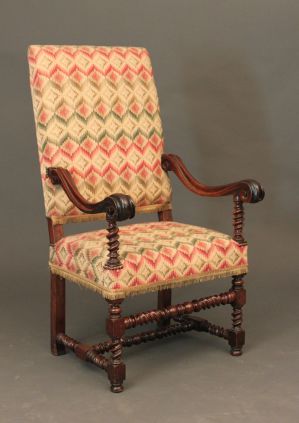Furniture during the reign of Louis XIII was monumental and heavy in style. The cabinet, usually on a stand and housing various small drawers, was the most important piece of non fitted furniture of the time. Generally made of walnut or ebony, it would have been decorated with panels, columns, and pilasters.
Ebony veneered cabinets made late into Louis XIII reign are embellished with flat relief carving, carved flowers, and twisted columns. Inspired by Augsburg cabinets that were made in Germany, which used ebony and other exotic materials in a decorative fashion.
The cupboard or buffet was popular at this time, especially in the provinces. This form slowly evolved into an armoire, which was mainly used for storing linens, rather than for the display of expensive household items, such as silver plates or ceramics.
Fall fronts were then added to cabinets, as seen on the typical varguenos, producing an early form of bureau. Small tables intended for the less formal rooms of a house were made in many shapes, but were mostly oblong, with turned legs.
Dining tables now had tops that could be extended, either with hinges or by the use of telescoping leaves. The table bases were usually turned, and H-stretchers provided a popular method of linking the table legs.
Chairs became far more comfortable towards the end of Louis XIII reign, as seats grew lower and wider, and the backs of the chairs became higher. There was a greater emphasis on textiles in Louis XIII handmade furniture, although upholstery was so expensive at this time that only the finest pieces of furniture were covered with textiles. Cushions were used for additional comfort on wooden seats, and chairs made for the upper classes were often covered with fashionable upholstery.
Velvet, damask, leather and needlework were all used. The fabric was fixed into place with rows of small brass tacks, which also served as a decorative element of the chairs. Fringe was added below the back seat rail and along the lower chair rail as an extra embellishment.
Armrests were usually curved and sometimes incorporated an upholstered pad. Chair legs were carved in a sculptural way, similar to the elaborate legs of Brustolon's chairs, or they were turned.
Decorative Detail
The Low Countries, especially Flanders, had a very strong influence on French furniture of the period. Two features typical of Louis XIII furniture were inspired by Flemish furniture - the heavy, moulded panelling in geometric patterns and elaborate turning on legs and stretchers.
Turning was an essential feature of Louis XIII furniture, now antique furniture, both in formal and vernacular pieces. It was now no longer used simply for legs and stretchers, but also to create decorative details on cupboards and cabinets. A piece of furniture would quite often feature more than a single turned design.
Early 17th century oak coffer (chest)
Walnut Open Armchair
A Louis XIII open armchair with fine spiral twist columns

No comments:
Post a Comment